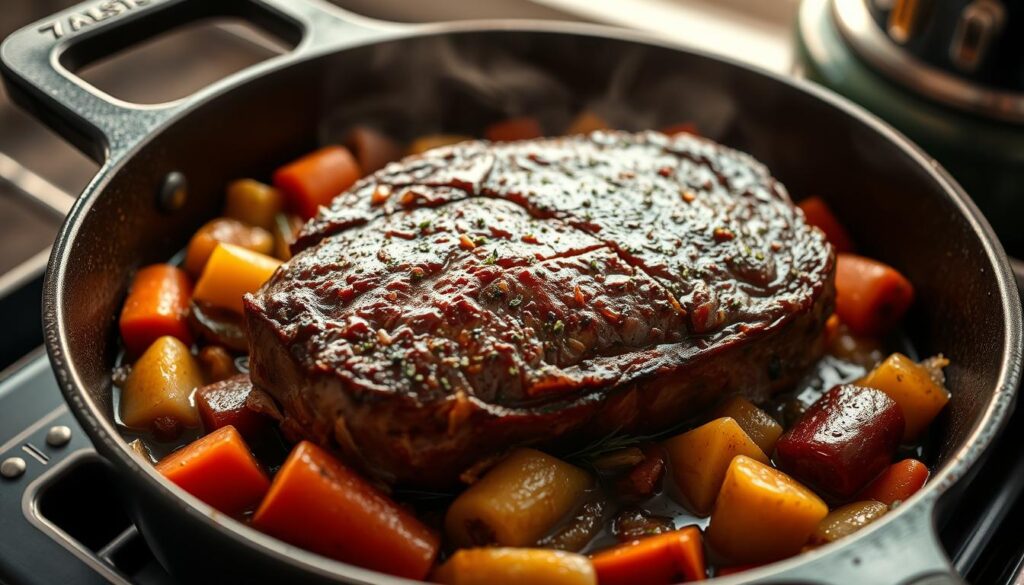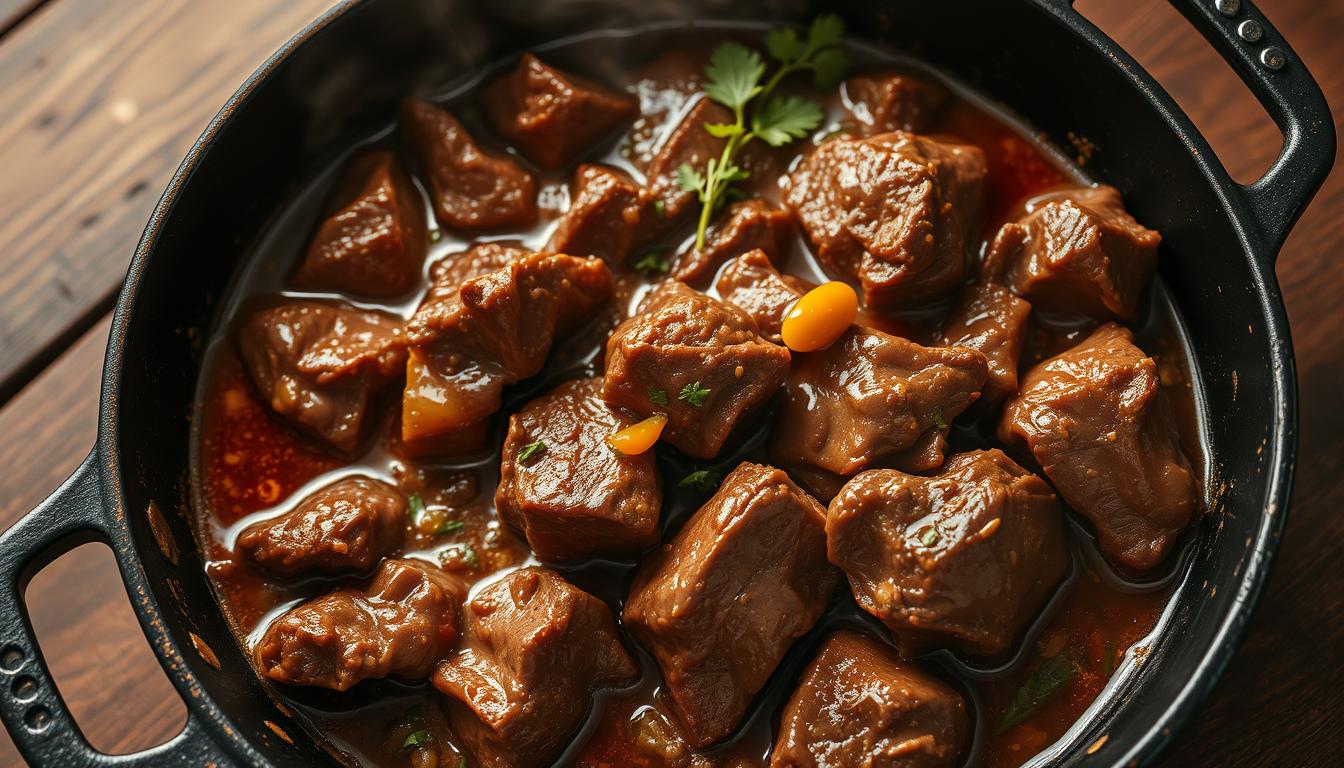Ever walked into a kitchen and felt warmth all around you? That’s what beef pares recipe does. It wraps you in tender beef and the scent of garlic and soy sauce. This Filipino classic is more than a meal; it’s a warm hug in a bowl.
Whether you’re new to cooking or have years of experience, this dish connects you to tradition and flavor. It’s hard to resist.
Table of Contents
Key Takeaways
- Beef pares recipe combines tender beef, aromatic spices, and garlic fried rice for a comforting meal.
- Originating from Filipino cuisine, it’s gained popularity nationwide for its rich, savory-sweet balance.
- Easily adaptable with ingredients like soy sauce, garlic, and your choice of tender beef cuts.
- Perfect for family dinners or gatherings, paired with simple sides like rice or noodles.
- Learn techniques to master the clear broth and juicy meat in this step-by-step guide.
Introduction: Discover the Magic of Beef Pares
Step into the world of filipino beef pares, a dish that blends tradition with craveable flavor. Born in the vibrant streets of Manila, this savory meal has evolved from a bustling market staple to a comforting home recipe. Whether you’re new to Filipino cuisine or a seasoned cook, this dish offers a journey of bold flavors and cultural richness.
Origins of Beef Pares
Rooted in the Philippines’ culinary heritage, beef pares started as a street food favorite. Over time, it became a beloved comfort meal in households, using tender beef simmered in a blend of garlic, soy sauce, and annatto. Its journey mirrors the creativity and resilience of Filipino cooking, adapting to different tastes without losing its soul.
Why You Should Try It
Cooking filipino beef pares lets you savor a harmony of savory, salty, and slightly sweet notes. The dish’s deep flavors make it perfect for sharing, and its recipe is adaptable—swap veggies or adjust spice levels to suit your palate. Every bite connects you to a legacy of flavors that’s both comforting and exciting.
Understanding the Key Ingredients
Choosing the right ingredients is key to a great dish, like how to cook beef pares. Let’s explore what makes this recipe special.
Essential Beef Cuts
Not all beef cuts are created equal for slow-cooked dishes. Here are your best options:
- Brisket: Its marbled fat makes it tender after long simmering.
- Chuck: Rich in connective tissue that turns into a silky texture.
- Short ribs: Their fall-off-the-bone bones add richness to the sauce.
Perfect Spices for Authentic Taste
Spices give the dish its unique aroma and flavor. Here’s how to mix them:
-
- Garlic & ginger: Grind them fresh for the best flavor.
Star anise: Use 1-2 pods for a hint of licorice.
- Soy sauce & fish sauce: They add saltiness and umami.
“The magic happens when spices work together, not overpower each other,” says Manila-based chef Lina Cruz.
| Spice | Role |
|---|---|
| Bay leaves | Subtle earthiness |
| Black pepper | Sharpness to balance sweetness |
| Knorr bouillon cubes | Quick base for savory depth |
Using the right cuts with these seasonings makes every bite of your beef pares rich. Are you ready? Let’s pick your beef!
Choosing the Right Beef for Your Pares
Finding the perfect beef is key to making amazing beef pares ingredients. The right cut makes the meat tender. Here’s how to pick:
- Brisket: Marbled with fat, this cut breaks down beautifully during slow cooking.
- Chuck: Affordable and flavorful, ideal for rich, hearty dishes.
- Shank: Collagen-rich, perfect for velvety sauces.
| Cut | Best For | Flavor Notes |
|---|---|---|
| Brisket | Long, slow stews | Deep beefy taste |
| Chuck | Chunky stews | Buttery richness |
| Shank | Sauces and soups | Unctuous texture |
“Tough meat never softens—always choose cuts with visible marbling.”
Choose cuts with visible fat veins. Avoid lean cuts like sirloin—they’ll dry out. Look for packages labeled “pot roasts” or “stew meat” at the store. Your patience in selecting the right cut ensures every bite of your beef pares ingredients shines.
Preparing Your Ingredients and Kitchen
Mastering beef pares recipe starts long before the first pan hits the stove. A well-organized kitchen and prepped ingredients make cooking stress-free. Let’s break down the steps to ensure everything is ready when you need it.
Prepping Vegetables
Vegetables are key to this dish’s texture and flavor. Begin by rinsing and drying all veggies thoroughly. Slice onions thinly and bell peppers into bite-sized strips. Carrots should be julienned or diced for even cooking.
Pro tip: Use a sharp knife to avoid bruising produce. Store each veggie in separate containers to prevent sogginess.
- Peel and chop garlic and ginger first—they lose flavor if left out
- Trim excess stems from leafy greens like bok choy
- Pre-measure spices and set them in one spot
Setting Up Your Workspace
A cluttered kitchen leads to mistakes. Clear counters of non-essential items and lay out your tools. Place the stove, cutting board, and mixing bowls within easy reach. Keep a trash bin nearby for scraps. Sanitize surfaces to prevent cross-contamination.
- Test all kitchen tools (grater, knife sharpness) beforehand
- Assign a dedicated prep area for wet/dry ingredients
- Plug in appliances like food processors if needed
Step-by-Step Beef Pares Recipe Overview
Learning to make beef pares recipe sauce takes patience and care. Follow these steps to turn tough cuts into tender, flavorful bites. Each step adds to the dish’s rich taste, from marinating to simmering.
Marinating the Beef
Begin by mixing the beef pares sauce recipe ingredients—soy sauce, garlic, and spices—to make a marinade. Place the meat in a resealable bag or dish to coat it well. Let it marinate for 2–4 hours, so the flavors soak into the meat.
- Combine ¼ cup soy sauce, 3 minced garlic cloves, and 1 tbsp black pepper in a bowl.
- Add the beef strips, making sure each piece is well-coated. Seal and refrigerate.
Cooking Techniques to Perfect Flavor
Heat oil in a pan and sear the marinated beef until it’s browned. Then, pour in the remaining marinade and water to start the sauce. Simmer it on low heat, letting the liquid thicken into a rich beef pares sauce recipe base.
- Brown the beef in a skillet, then add onions and bell peppers.
- Simmer uncovered for 1 hour, stirring now and then to blend the flavors.
- Adjust the seasoning with salt or sugar to get the sauce’s taste just right.
Keep the heat low to make the meat tender without drying it out. The dish should have a glossy sauce that sticks to the beef. It’s now ready to serve over rice or with garlic rice.
Cooking Tips: How to Achieve Tender Beef
Learning to make tender beef in your beef pares recipe is easy. Even tough cuts like chuck or brisket can become tender with the right methods.
1. Simmer Slowly: Don’t rush it. A slow simmer (around 180°F) breaks down tough parts without making the meat hard. Cover the pot and let it cook for 2–3 hours without stirring.
2. Slice Smart: Always cut meat against the grain. This makes each bite tender. Look for the grain’s direction before you slice.
3. Temperature Watch: High heat makes meat chewy. Use a thermometer to keep the pot at a low boil. A candy thermometer is very helpful here!
“The secret to Filipino beef pares is patience. Let the pot do the work.” – Chef Lourdes Montinola, Pinoy Kitchen Chronicles

Pro tip: Add a splash of vinegar during cooking. It tenderizes the meat and adds flavor. Don’t overcrowd the pot—this lets meat cook evenly.
- Pat dry beef before searing to get a perfect crust.
- Let meat rest 5–10 minutes after cooking to keep juices in.
Don’t overcrowd the pot or simmer too fast. These mistakes can make meat tough. Follow these steps, and your beef pares will be amazing!
Mastering the Authentic Beef Pares Sauce Recipe
Every great dish starts with a foundation of flavor—and Beef Pares is no exception. The sauce makes this dish unforgettable. Let’s learn how to make it perfectly.
Creating the Rich, Aromatic Sauce
Start by simmering soy sauce, brown sugar, and star anise in a pot. Stir until the sugar dissolves, creating a deep umami base. Add minced ginger and garlic for warmth.
Let the mixture reduce slightly to concentrate the taste. Pro tip: Use a wooden spoon to scrape any caramelized bits from the bottom of the pan—this adds complexity.
Balancing Sweet and Savory Flavors
- Start with ¼ cup soy sauce as your salty base.
- Add 2 tablespoons brown sugar gradually to avoid overpowering the dish.
- Season with 1-2 star anise pods for licorice undertones.
- Test the balance by tasting frequently. Adjust with a dash of fish sauce for salt or a squeeze of lime to brighten sweetness.
Remember: The goal is harmony. Sweetness should complement, not dominate. A well-balanced sauce elevates every bite of your Beef Pares.
How to Cook Beef Pares: Detailed Cooking Instructions
Mastering beef pares cooking starts with precision. Follow these steps for tender results every time.
Precise Temperature Control
Temperature is crucial for tender meat. Here’s how to get it right:
- Simmer on the stovetop at 200°F or in the oven at 325°F for even heat.
- Avoid boiling. Keep the sauce at a gentle bubble to prevent toughness.
Timing and Browning Techniques
Follow these steps for a golden crust and rich flavor:
- Preheat the pan to medium-high. Sear the beef for 3-4 minutes on each side until caramelized.
- Simmer uncovered on low heat for 2-3 hours, stirring occasionally.
| Step | Temperature | Time |
|---|---|---|
| Searing | Medium-High | 3-4 minutes/side |
| Simmering | Low heat | 2-3 hours |
Pro tip: Use a meat thermometer to check internal temps. Beef is perfect at 195°F.
Exploring Variations: Filipino Beef Pares and Beyond
Love the basics but crave something new? Try Filipino Beef Pares variations to make it your own. Small tweaks can turn tradition into something fresh.
“The best recipes evolve. Let your taste shape the next great dish.”
Here are some ideas to reinvent your beef pares recipes:
- Add bone marrow for rich, buttery depth in the broth.
- Swap bell peppers with mushrooms or eggplant for earthy textures.
- Layer heat with Knorr’s Sazón seasoning or McCormick smoked paprika.
- Throw in diced chorizo for a spicy kick or tofu for a plant-based twist.
- Simmer in a slow cooker for tender meat with hands-off ease.
Play with veggies, proteins, or spices until it’s exactly how you like it. Share your version and inspire others to cook with confidence. Your next favorite meal starts with one small change.
Pairing Suggestions for an Unforgettable Meal
Serving the best beef pares recipe is even better with the right sides and drinks. These pairings can turn a good meal into a memorable feast.
Complementary Side Dishes
Balance bold flavors with these easy options:
- Garlic fried rice: Adds umami depth.
- Steamed jasmine rice: Softens spicy notes.
- Fried egg: Top a portion with a runny yolk for creaminess.
- Pickled vegetables: Try vinegar-soaked carrots for tangy contrast.
- Chili sauce: Add heat with store-bought or homemade.
Drink Pairings to Enhance Flavor
Match your best beef pares recipe with:
- Lager or IPA: Crisp beer cuts through richness.
- Red wine: Full-bodied Cabernet or Merlot.
- Iced tea or soda: Lemonade or ginger ale for refreshment.
Pairing ideas make all the difference. Experiment to find your favorite combos!
Troubleshooting Common Cooking Challenges
Even the best recipes can face problems. If your beef pares recipe doesn’t turn out right, don’t worry. These tips can help you fix tough meat or off-kilter sauces and make them taste like they came from a restaurant.
- Choose chuck or brisket for natural tenderness
- Marinate at least 2 hours—acid (lemon or vinegar) breaks down fibers
- Overcooked? Slice against the grain to shorten muscle strands
Fixing Sauce Consistency
Too thick? Stir in broth ¼ cup at a time. Sauce too thin? Simmer uncovered until reduced. For extra body, whisk in cornstarch mixed with water. Taste as you adjust—salt and fish sauce can balance flavors.
Pro tip: Let sauce simmer 10-15 minutes longer if flavors feel weak. For overly salty dishes, add a raw potato slice—it absorbs excess salt.
Serving Your Best Beef Pares Recipe with Style

Turn your beef pares recipe into a work of art with great presentation. Use a deep plate to show off the tender beef and veggies. Place the beef slices in a circle, letting the juices shine.
Here’s how to shine:
- Pour sauce evenly around—not over—the beef to keep flavors distinct.
- Add crunch with a sprinkle of fried garlic or toasted sesame seeds.
- Finish with a chiffonade of fresh herbs like cilantro or basil.
Pro tip: Serve extra sauce in a small bowl for dipping. Use these garnish ideas to add flair:
- Thinly sliced green onions for color
- Edamame or pickled radish for texture contrast
- Drizzled chili oil for bold visual pops
Aquote from Manila’s top pares chefsadvises: “Let the broth shine by pouring it through a sieve before serving.” Place steamed rice in a separate bowl to keep grains fluffy and flavors separate.
Remember, the authentic recipe’s story continues on the plate. Layer elements thoughtfully—crisp toppings over soft ingredients, bright colors against neutral backgrounds. Every bite should feel intentional, from the first glance to the last savory sip.
Tips for Storing Leftovers and Meal Planning
Planning ahead makes it easy to enjoy beef pares recipe again without sacrificing taste. Divide leftovers into meal-sized portions before storing. This saves time and keeps flavors fresh.
- Store cooked beef and sauce separately in airtight containers. Keep in the fridge up to 3 days.
- Freeze portions in freezer-safe bags. Label with dates for easy tracking.
- Reheat small batches in the microwave or oven. Add a splash of broth to restore moisture.
| Storage Method | Time Frame | Best Practices |
|---|---|---|
| Refrigerator | 3-4 days | Cover tightly to prevent odor transfer |
| Freezer | 2-3 months | Use heavy-duty wrap for meat to avoid freezer burn |
| Reheating | As needed | Heat at 325°F for 15-20 minutes for even warmth |
Meal planning? Prep ingredients in advance. Chop veggies and marinate beef the night before cooking. Store dry ingredients like spices in airtight jars for freshness. Leftover sauce? Use it as a base for pasta or stir-fry.
Conclusion
Learning to make beef pares recipe sauce is key to enjoying this dish. You’ve learned how to pick the right beef, mix spices, and create a rich sauce. Each step, from marinating to browning, is crucial for a delicious meal.
Don’t be afraid to try new things. Change the sauce’s sweetness, add different veggies, or serve it with rice. Every change makes the dish your own. Tips on timing and temperature help even beginners get great results.
It’s time to start making your own beef pares recipe. Get your ingredients ready and follow the steps. Whether you’re cooking for family or yourself, making this dish at home is rewarding. Share your dishes online, tag your favorite moments, and keep trying new things. Beef pares sauce is more than a meal; it’s a way to connect with food and culture.

